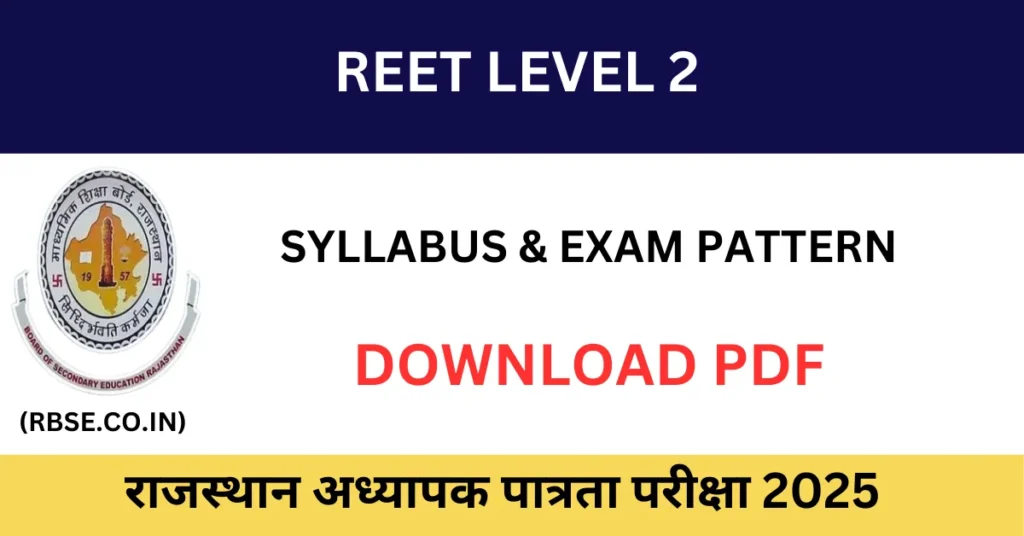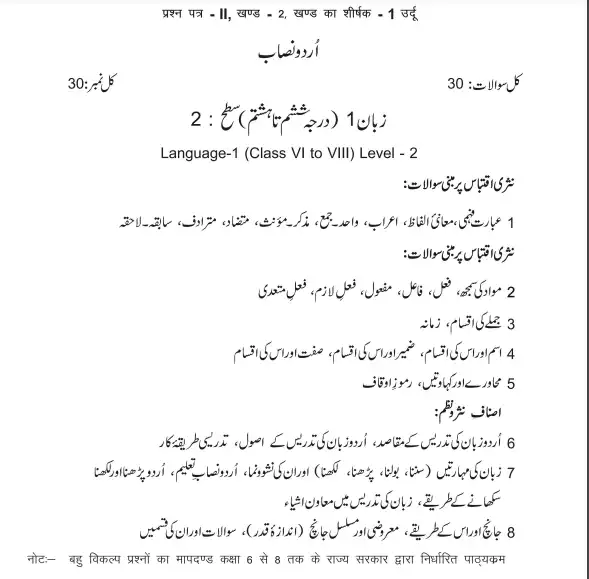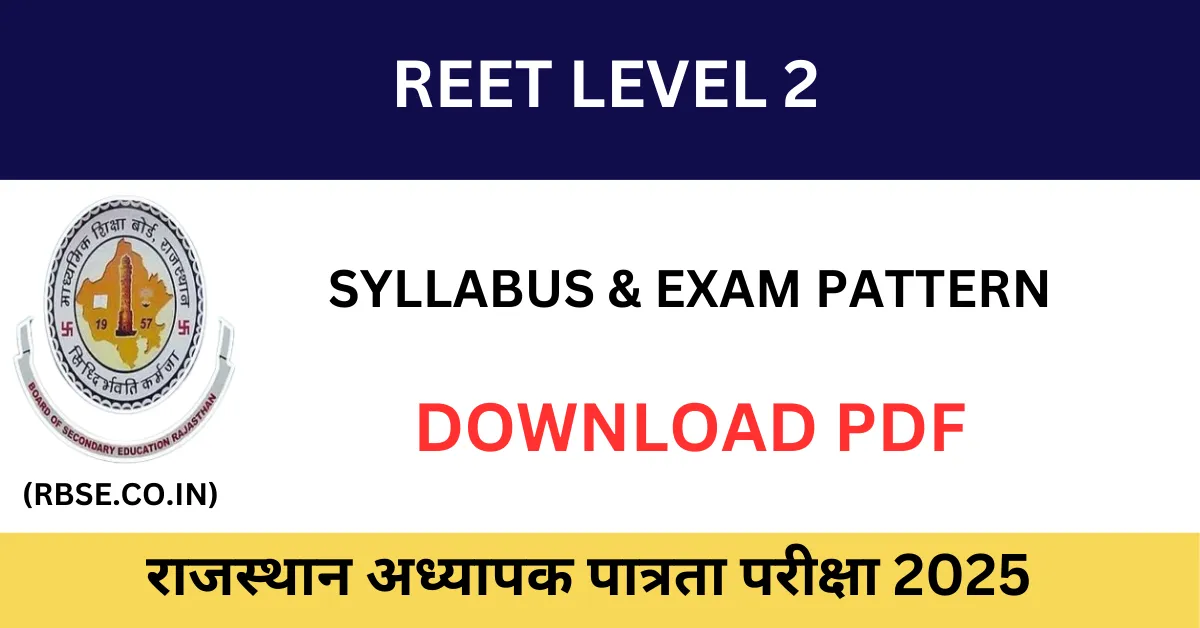REET Level 2 Syllabus 2025: As you all know, the application form for Rajasthan REET Level 22024 25 is being filled from 16 December 2024 to 15 January 2025 and its examination can be held in the expected February month. This post is going to prove to be very important and in this post, information about the syllabus and exam pattern for REET Level 2 will be given. Let us tell you that the candidates of REET Level 2 will be selected to teach the third grade teacher level 2 i.e. classes 6 to 8.
This website will be very beneficial for all the candidates preparing for REET Level 2 because on this website we will keep updating new questions and answers daily and you will be able to take the exam to solve the model question paper. REET Level 2 Syllabus 2025 PDF Free Download, REET Level 2 Syllabus 2025 Science, REET Level 2 Syllabus PDF Download, REET Syllabus Level 2, REET Level 2 Syllabus in Hindi, REET Level 2 Syllabus 2025 Paper 2, REET Syllabus Level 2 PDF in Hindi, REET Pre Syllabus Level 2.

Overview
| Organization Name | Board of Secondary Education Rajasthan |
| Post Name | Teacher 3rd Grade (Level 2) |
| Vacancies | Notified Later |
| Last Date | 15-01-2025 |
| official website | BSER |
Exam Pattern for Rajasthan REET Level 2
The following information must be known for the Rajasthan REET Level 2 exam-
- The Rajasthan Teacher Eligibility Test (REET) 2024-25 exam will be of 150 marks tomorrow and the total questions will also be 150 marks.
- Candidates will be given 2 hours and 30 minutes for the exam.
| Part | Subject | Total no. of Questions | Total marks |
| Part I | Child Development & Pedagogy | 30 | 30 |
| Part II | Language I (Hindi, Sindhi, English, Sanskrit, Urdu, Punjabi & Gujarati) | 30 | 30 |
| Part III | Language E (Hindi, English, Sanskrit, Urdu, Sindhi, Punjabi & Gujarati) | 30 | 30 |
| Part IV | Mathematics & Science (for Maths & Science Teachers). Social Science for Social Science Teachers or Other Subjects Teacher | 60 | 60 |
| Total | 150 | 150 | |
Rajasthan REET 2025 Level 2 Syllabus Subjectwise
1. REET Level 2 Psychology (Child Development & Teaching Methods)
- Child Development:
- Concept of Growth and Development
- Different Dimensions and Theories of Development
- Factors influencing development (especially in the context of family and school)
- Relationship Between Development and Learning
- Sequence and Environment:
- The role of the sequence and the environment
- Individual Variations:
- Meaning and types
- Factors influencing individual differences
- Personality:
- Concept & Types
- Factors Influencing Personality
- Measurement of Personality
- Wisdom:
- Concept & Theory
- Measurement of intelligence
- Multiintelligence theory and its implications
- Understanding of Diverse Learners:
- Backward children
- Deranged children
- Talented and creative children
- Disadvantaged and disadvantaged children
- Children with special needs
- Children with attachment disabilities
- Attainment:
- Difficulties in learning
- Meaning and Concept of Learning
- Factors Influencing Learning
- Theories of Learning and its implications
- How do children learn?
- Processes of learning (thinking, imagining and reasoning)
- Adjustment:
- Concept and Methods of Adjustment
- Teacher’s Role in Adjustment
- Motivation:
- The Importance of Motivation
- of Motivation for Learning
- Teaching-Learning Processes:
- Teaching-learning strategy in the context of National Curriculum Framework (NCF) 2005
- Teaching-learning methods
- Assessment, Measurement and Evaluation:
- Meaning and purpose
- Comprehensive and Continuous Evaluation (CCE)
- Creation of achievement testing
- Learning Rewards
- Research:
- Action Research
- Right to Education Act (RTE) 2009:
- Role and Responsibilities of Teachers
2. REET Level 2 Syllabus – हिंदी
- Grammatical questions from unread passages:
- Synonyms
- antonym
- A word for phrases
- literal meaning
- Word Purification
- Word Structure:
- Prefixes and suffixes
- Treaty and Alliance
- Nouns, Pronouns, Adjectives, and Adjectives
- Questions based in unread passages:
- Clarifying the meaning of underlined words
- Finding Word, Tense, and Gender
- Changing the pronunciation, tense and gender of given words
- Syntax:
- Parts of the sentence
- Sentence Types
- phrase
- Word Usage:
- Idioms and proverbs
- punctuation
- Language Teaching:
- Language Teaching Method
- Approaches to Language Teaching
- Development of language proficiency
- Development of Linguistic Skills:
- Listening, Speaking, Reading, and Writing
- Challenges in Hindi Language Teaching
- Teaching-learning materials (textbooks, multimedia, and other resources)
- Evaluation and Testing:
- Assessment in Language Teaching
- Creation of achievement testing
- Comprehensive and Continuous Evaluation
- Remedial learning
Note: Criteria of Multiple Choice Questions: The level of difficulty will be as per the text books and text content of the syllabus (session 2021-22) specified by the state government from classes 1 to 5 as per the textbooks up to secondary (class 10).
3. REET Level 2 Syllabus – संस्कृत
- Ekam apathitam gadyansham adharikritya as follows: grammar-related: prashnaH –
- Shabdrupa-dhaturupa-karaka-vibhakti-prefixa-suffix- sandhi-samas-pronoma-adjective-avyeshu prashna:-ekam apathitam gadyansham Rajasthanasya itihasam kalam sanskriti chadharikritya following- bindusambandhinahprashna:-
- ṣṭ��
- Lakaraparivartana-prashnaH (lat-lad-lrit-vidhilidlakareshu
- Number Knowledge- Maheshwar-Sutra-Sambandhin: Question:-
- Sanskrit translation, speech change (lat-lakarsya) sentence-question-making, inaccuracy research, Sanskritsuktaya.
- Sanskrit language-teaching-method. Sanskrit language-teaching theory.
- Sanskrit bhashakaushalasya vikasah, (shravanam, sambhasanam, reading, lekhnam)
- Sanskrit teaching, textbooks, communication tools.
- Sanskrit-takshanasya evaluation-related: questions, oral-written questions, type-continual evaluation, remedial teaching.
4. REET Level 2 Syllabus 2025 – अंग्रेजी (English)
- Unseen Prose Passage:
- Synonyms
- Antonyms
- Spellings
- Word-formation
- One-word Substitution
- Unseen Prose Passage (Grammar Focus):
- Parts of Speech
- Tenses
- Determiners
- Degrees of Comparison
- Question Framing:
- WH-questions
- Active and Passive Voice
- Narration
- Knowledge of English Sounds and Phonetic Symbols
- Teaching English:
- Principles of Teaching English
- Methods and Approaches to English Language Teaching
- Development of Language Skills:
- Listening
- Speaking
- Reading
- Writing
- Teaching-Learning Materials:
- Textbooks
- Multi-Media Materials
- Other Resources
- Evaluation in English Language:
- Comprehensive & Continuous Evaluation
- Construction and Analysis of Evaluation Tools
5. REET Level 2 Syllabus 2025 – गणित, विज्ञान (Science & Maths)
Let us tell you that there is a syllabus of Science and Mathematics for the Rajasthan REET Level 2 exam, there is only one exam for this and there is only one teacher for Science who studies in Science from class 6 to 8.
- Sign or index of power as 2³ = 2 × 2 × 2:
- Multiplication and division of exponential numbers of the same base
- Exponential laws
- Algebra:
- Addition, Subtraction, Multiplication and Division of Algebraic Expressions
- Identities
- Factors of Simple Algebraic Expressions
- Simple uniexponential equations
- Square and Square Root
- Cube and Cube Root
- Interest:
- Simple Interest
- compound interest
- Advantages and harms
- Ratio and Proportion:
- Division into proportional parts
- different
- percentage
- Births and deaths
- Population Growth and Decline
- Lines and Angles:
- Line section
- Simple and curved lines
- Types of Angles
- Planar Shapes:
- triangle
- Congruence of Triangles
- Quadrilaterals and Circles
- polygon
- Area and Perimeter of Planar Shapes:
- triangle
- long
- Parallelogram
- Trapezium
- Surface Area and Volume:
- cloud
- Cuboid
- Rhombus Cylinder
- Statistics:
- Collection and classification of data
- Frequent bunting table
- Matching Marks
- Column (Bar) Graph
- Rectangle map
- Circular Graph (Pie Chart)
- Graph:
- Different Types of Graphs
- प्रायिकता (Probability)
- Nature of Mathematics and Reasoning Power
- Importance of Mathematics in Curriculum
- The Language of Mathematics
- Community Math
- Assessment and remedial teaching
REET Syllabus 2025 for Science
Living and Non-living: Introduction, Differences and Characteristics
- Living:
- Types of plants and their different parts.
- Nutrition, respiration and excretion in plants.
- Structure and function of plant and animal cells.
- Cell division.
- Micro-organism:
- Types: bacteria, viruses, fungi.
- Beneficial and unremunerative microorganisms.
Human Body & Health
- Diseases Spread by Micro-organisms:
- Tuberculosis, measles, diphtheria, cholera, typhoid.
- Measures to prevent diseases.
- Different mechanisms of the human body.
- Contagious disease:
- Causes and prevention of the spread.
- Meals:
- Sources of food.
- The main ingredients of food.
- Diseases caused by their deficiency.
- Balanced food.
Animal Reproduction and Adolescence
- Methods of Reproduction:
- Sexual and asexual.
- Adolescence and Puberty:
- Physical changes.
- The role of hormones in reproduction.
- Reproductive Health.
mechanic
- Force and Motion:
- Types of Forces: Galvanic Force, Frictional Force, Gravitational Force, Magnetic Force, Static Electrostatic Force.
- Types of Motion: Linear, Circular, Vibrational, Periodic and Rotational Motion.
- Pressure and buoyant force.
- Work and Energy:
- Conventional and Alternative Energy Sources.
- Energy conservation.
Heat & Heat
- What is the meaning of heat and heat?
- Thermometer.
- Heat transmission.
Light & Sound
- Light:
- Sources of light.
- Reflection and refraction.
- Formation of spherical mirrors, plane mirrors, lenses and images from them.
- Sound:
- Properties of sound.
- Sound transmission.
Electricity & Magnetism
- Electric current and circuit.
- Thermal, magnetic and chemical effects of electric current.
- Magnets and magnetism.
Science & Technology
- Importance of Science in Daily Life.
- Synthetic fibres and plastics.
- Properties and types.
- Impact on the environment.
- Other useful substances:
- Detergents, cement, etc.
- Science in the Medical Field:
- X-ray, CT scan, surgery.
- Ultrasound and laser rays.
- Telecom Sector:
- Fax machines, computers, internet, e-mail and websites.
Solar System
- The Moon and the Stars.
- Solar System: Sun, Planets, Comets, Constellations.
Composition of matter
- Atoms and molecules.
- Structure of atom.
- Elements, compounds and mixtures.
- Separation of the ingredients of the mixture.
- Symbols of Elements and Chemical Formulae of Compounds.
- Physical and chemical changes.
Chemical substances
- Oxides.
- The greenhouse effect and global warming.
- Hydrocarbons.
- Acids, bases and salts.
- Oxygen gas, nitrogen gas, nitrogen cycle.
- Coal, Petroleum and Natural Gas.
6. REET Level 2 Syllabus 2025 – सामाजिक SS
Indian Civilization, Culture and Society
- Indus Valley Civilization.
- Vedic Culture.
- Jainism and Buddhism.
- Mahajanapada period.
- Mauryan Period and Administration.
- Gupta Empire and Post-Gupta Period.
- Political History of India (600-1000 A.D.).
- Indian Culture and Heart Expansion (Heart India).
- Bhakti and Sufi movements.
- Mughal-Rajput Relations and Mughal Administration.
- British policy towards Indian states.
- Revolt of 1857.
- British Influence on Indian Economy.
- Renaissance and Social Reform.
- Indian National Movement (1885-1947).
Indian Constitution and Democracy
- Structure and Features of the Indian Constitution.
- Preamble, Fundamental Rights and Fundamental Duties.
- Social Justice: Child Rights and Child Protection.
- Election and Voter Awareness in Democracy.
- Parliament.
- The President, the Prime Minister and the Council of Ministers.
- Supreme Court.
- State Government.
- Panchayati Raj and Urban Self-Government (in the context of Rajasthan).
- District Administration and Judicial System.
The Earth and Our Environment
- Latitude and longitude.
- Movements of the Earth.
- Air pressure and winds.
- Cyclone and counter-cyclone.
- Ocean circulation.
- Volcanoes and earthquakes.
- Environmental Problems and Solutions.
Geography and Resources of India
- Topography and region.
- Climate.
- Natural Vegetation and Wildlife.
- Multipurpose River Valley Projects.
- Soil and agricultural crops.
- Industry and Minerals.
- Transportation.
- Population and Human Resources.
- Economic and social programmes of development.
Geography and Resources of Rajasthan
- Physical region.
- Climate and drainage system.
- Lakes.
- Soil Water Conservation and Storage.
- Agricultural crops.
- Mineral and Energy Resources.
- Major Canals and River Valley Projects of Rajasthan.
- Transportation.
- Industry and Population.
- Tourist places.
- Forests and wildlife.
History of Rajasthan
- Ancient Civilizations and Districts.
- Major dynasties of Rajasthan.
- Rajasthan’s contribution to the revolt of 1857.
- Praja Mandal, Tribal and Peasant Movements.
- Unification of Rajasthan.
- Prominent personalities of Rajasthan.
Art and Culture of Rajasthan
- Heritage of Rajasthan: Forts, palaces, monuments.
- Fairs and festivals.
- Folk Arts and Painting.
- Folk Dance and Folk Drama.
- Folk deities, saints and music.
- Handicraft and Architecture.
- Costumes and jewellery.
- Language and Literature.
Pedagogical Issues
- Concept and Nature of Social Sciences.
- Procedures, Activities and Discussions in the Classroom.
- Problems of Pedagogy of Social Studies.
- Development of critical thinking.
- Questioning and empirical evidence.
- Teaching-learning materials.
- Information and Communication Technology.
- Project work.
- Learning Outcomes and Assessment.
| REET LEVEL 1 SYLLABUS | DOWNLOAD REET LEVEL 1 SYLLABUS |
7. REET Level 2 Syllabus 2025 – Urdu (उर्दू)

7. REET Level 2 Syllabus 2025 – सिन्धी भाषा
- Art, Literature, Culture, and History of Rajasthan
- Main topics of books related to art, culture and history of Rajasthan:
- Unwan: Title and Contents.
- Key Terms: Meaning, Classification, Gender, Type, Qualities, and Style.
- Excerpts from the text: Important quotes or definitions.
- Main topics of books related to art, culture and history of Rajasthan:
- Introduction to Sindhi Language
- Alphabet and Script: Introduction to the Sindhi alphabet and information on scripts.
- Grammar:
- Nouns, pronouns, verbs, genders, words, and tenses.
- Methods of word formation.
- Uses of Sindhi Language:
- Ways of speaking, reading, writing, and learning.
- Use of teaching materials and supporting materials.
- Sindhi Grammar and Structure
- Word Structure:
- Gender, Speech, Tense, Sentence Structure and Characteristics.
- Course Methods:
- The practice of speaking and writing.
- Effective methods of teaching and assessment.
- Word Structure:
- Study of Sindhi Literature
- Major works and their authors.
- Methods of reading, writing, and interpreting.
- Historical and Cultural Aspects of Language and Literature.
- Objectives of the study and teaching of Sindhi language
- The importance of reading, teaching and writing the Sindhi language.
- Methods of Assessment and Improvement in Teaching.
- process of formulating and answering oral and written questions.
| Download PDF | REET Level 2 Syllabus pdf |
